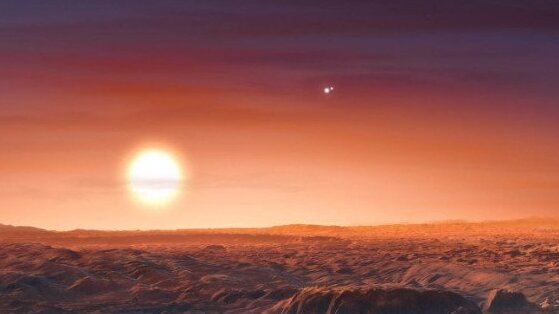
Is the Earth the only habitable planet in the universe, or are there other places out there that are capable of supporting life? And if there are, what might they look like? In order to answer these fundamental questions, scientists are searching for exoplanets, i.e. planets outside our solar system that orbit other stars. A study by Dr Markus Mugrauer, astrophysicist at the University of Jena, shows that the Sun rises several times in many of these distant worlds.
More than 4,000 exoplanets have been found so far. Most of them orbit single stars, much like the Earth orbits our Sun. How ever, astrophysicist Dr Markus Mugrauer has now discovered numerous multiple star systems with exoplanets. In other words, these exoplanets orbit one of several »suns«.
Precise data supplied by the Gaia space observatory
»Multiple star systems are very common in our Milky Way,« explains Mugrauer. »If such systems include planets, they are of particular interest to astrophysicists, because their planetary systems can differ from our solar system in fundamental ways«. To find out more about these differences, Mugrauer scanned more than 1,300 host stars—where exoplanets have been found—in search of companion stars. For this purpose, he accessed the precise observational data supplied by the Gaia space observatory, which is operated by the European Space Agency (photo on p. 5). In this way, he detected about 200 companion stars to exoplanet host stars that are up to 1,600 light years away from the Sun.
With the Gaia data, Mugrauer was able to characterize the newly discovered companion stars and their systems in detail. He found that there are both, close systems with separations of only 20 astronomical units (au)—which, in our solar system, roughly corresponds to the distance between the Sun and Uranus—as well as systems in which the stars are separated by more than 9,000 au.
The companion stars also vary in terms of their mass, temperature, and stage of evolution. The heaviest among them weigh 1.5 times more than our Sun, while the lightest have just under one tenth of our Sun’s mass. Most of the companion stars are lowmass, cool dwarf stars that glow faintly red. However, eight white dwarfs were also identified amongst the faint companions. A white dwarf is the burntout core of a sunlike star, which is only about as big as our Earth, but half as massive as our Sun. These observations show that exoplanets can indeed survive the final evolutionary stage of a nearby sunlike star.
Double, triple and quadruple star systems with exoplanets
While the majority of the star systems with exoplanets found in the study are double stars, Mugrauer also detected twelve hierarchical triple and even quadruple star systems. A total of 15% of the stars examined have at least one companion star. Mugrauer mentions one of the key findings of his work: »This is only about half the frequency expected in general for sunlike stars within that range of separation«. Furthermore, the companion stars detected show separations about five times wider than in ordinary systems. »These two findings together could indicate that multiple stars in a solar system influence the formation process of planets as well as their orbital evolution,« explains Mugrauer. This is firstly because of the gravitational interac tion of the companion stars with the gas and dust discs in which planets are formed. Their gravitational then interferes with the movement of the planets around their host stars.
Markus Mugrauer would like to pursue the project to examine the multiplicity of newly discovered exoplanet host stars using data obtained from the Gaia mission and to precisely characterize the detected companion stars. »In addition, we will combine our results with those of an international observing campaign, which we are currently running on the same topic at the Paranal Observatory of the European Southern Observatory in Chile,« adds the expert from Jena. »That will allow us to investigate the precise influence of the stellar multiplicity on the formation and evolution of planets.«
By Till Bayer
Original-publication: Search for stellar companions of exoplanet host stars by exploring the second ESA-Gaia data release. MNRAS (2019), DOI: 10.1093/mnras/stz2673External link